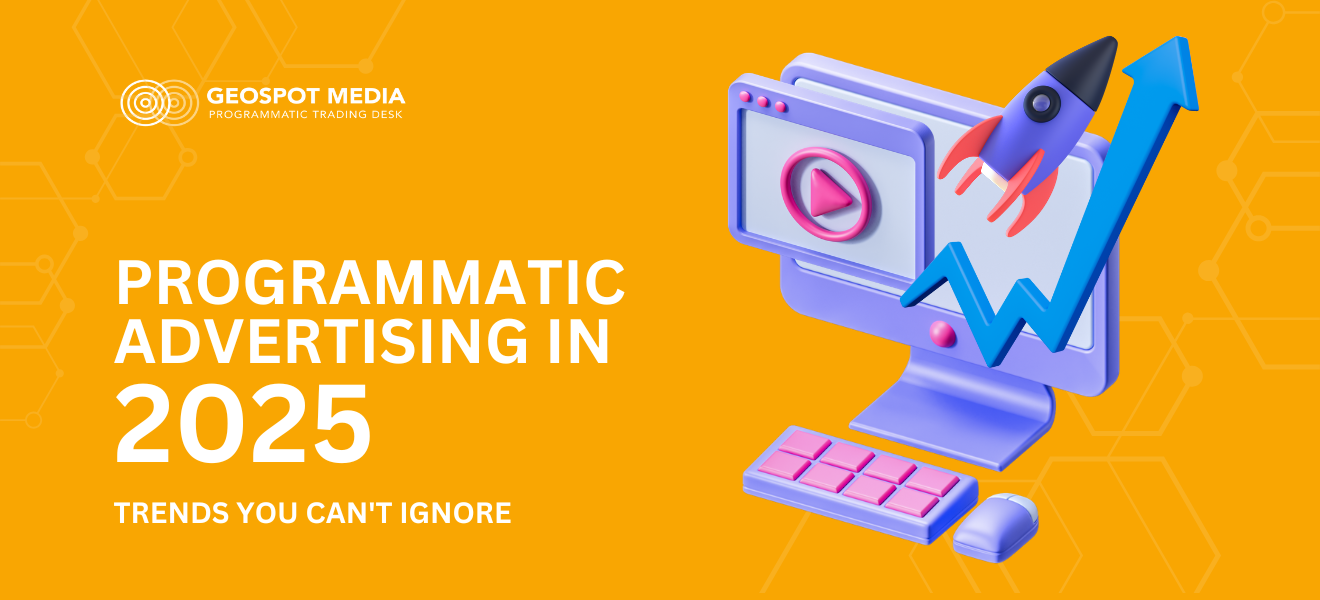Programmatic Advertising in 2025 – Trends You Can’t Ignore
The world of programmatic advertising is transforming rapidly, ushering in a new era of innovation, efficiency, and responsibility. Staying ahead of these changes is not just an option—it’s a necessity. In 2025, key trends will shape the future of programmatic advertising, and understanding them will help businesses thrive in this dynamic environment. Let’s dive into the five trends poised to redefine the industry.

1. AI-Powered Optimization: The Engine Behind Smarter Campaigns
In 2025, AI in programmatic advertising will no longer be a buzzword; it will be the backbone of programmatic advertising. From dynamic creative optimization to real-time bidding strategies, AI will enhance the precision and impact of campaigns.
- Advanced Predictive Analytics: AI algorithms will analyze historical data to predict the best-performing ad placements, optimizing ROI.
- Hyper-Personalized Ads: Machine learning will generate tailored messages, ensuring relevancy for every audience segment.
- Efficiency at Scale: Automation will handle bidding, pacing, and budget allocation, saving time and reducing errors.
Example in Action:
A major automotive brand leveraged AI to tailor creative ads to specific user interests, resulting in a 45% higher click-through rate compared to traditional targeting.
Takeaway:
Adopt AI-driven platforms like IBM Watson Advertising or Adzooma to unlock untapped potential in your campaigns.
2. Privacy-Centric Advertising: The Cookieless Future is Here
With regulations like GDPR and CCPA reshaping the advertising ecosystem, privacy-centric advertising solutions will dominate in 2025. The phase-out of third-party cookies has pushed advertisers to find compliant yet effective targeting methods.
- Contextual Targeting: Ads will be served based on content relevance rather than user behavior.
- First-Party Data: Businesses will lean on direct customer data to build strong, permission-based relationships.
- Emerging Technologies: Tools like Google’s Privacy Sandbox and FLoC will help bridge the gap between privacy and performance.
Example in Action:
A retail chain adopted a privacy-first strategy using first-party data to create targeted ads for loyalty program members, achieving a 30% boost in conversions.
Takeaway:
Invest in robust Customer Data Platforms (CDPs) like Segment or Treasure Data to secure a competitive edge in this privacy-focused landscape.
3. Connected TV (CTV) and OTT: Where Viewers Meet Advertisers
CTV and OTT advertising trends in 2025 are rewriting the rules of audience engagement. By 2025, these channels will account for a significant share of programmatic ad spend as more consumers ditch traditional TV for streaming services.
- Interactive Formats: Shoppable ads and clickable overlays will drive engagement.
- Advanced Targeting: AI-powered segmentation will enable precise audience reach based on demographics and viewing habits.
- Cross-Channel Integration: Advertisers can synchronize campaigns across devices for a cohesive user experience.
Example in Action:
A streaming service launched a CTV campaign during a live sports event, generating 60% higher engagement compared to display ads.
Takeaway:
Platforms like Roku, Hulu Ad Manager, and GeoSpot Media are excellent starting points to explore CTV and OTT opportunities.
4. Sustainability in Advertising: Making an Impact Beyond Profit
As environmental concerns grow, sustainable advertising strategies are becoming a defining trend. Brands will embrace eco-conscious strategies not only to reduce carbon footprints but also to resonate with values-driven consumers.
- Green Ad Servers: Servers running on renewable energy will minimize the environmental impact of ad delivery.
- Carbon-Neutral Campaigns: Advertisers will offset emissions through verified programs.
- Purpose-Driven Messaging: Campaigns will showcase brands’ sustainability efforts, fostering trust and loyalty.
Example in Action:
A skincare brand highlighted its use of sustainable packaging in programmatic ads, leading to a 25% increase in brand favorability among eco-conscious audiences.
Takeaway:
Collaborate with platforms like Good-Loop, which offer carbon-neutral advertising solutions, to align your campaigns with sustainability goals.
5. Blockchain for Transparency and Fraud Prevention: The Trust Revolution
Blockchain in programmatic advertising is reshaping the industry by introducing transparency, reducing fraud, and ensuring accountability throughout the ad supply chain.
- Immutable Records: Blockchain creates an unalterable ledger of ad transactions.
- Fraud Detection: Verifying impressions and clicks ensures only genuine engagements are billed.
- Direct Deals: Smart contracts eliminate intermediaries, maximizing advertiser ROI.
Example in Action:
A global FMCG brand implemented blockchain solutions to monitor its programmatic campaigns, reducing ad fraud by 20% and improving budget efficiency.
Takeaway:
Ad tech platforms like MadHive and Lucidity are pioneering blockchain applications in programmatic advertising. Consider integrating these tools into your strategy.
Conclusion: Ready for 2025?
These trends represent not just advancements but shifts in how the programmatic advertising ecosystem operates. From AI and privacy to sustainability and transparency, embracing these changes is essential for staying relevant in 2025.
Actionable Tip: Start by evaluating your current programmatic advertising setup—identify gaps and explore how these trends can align with your goals for the year ahead.
By preparing now, you’ll ensure your campaigns are not just effective but transformative. Let’s innovate, adapt, and lead in 2025.




Post Comment